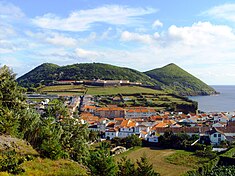Fortress of São João Baptista (Angra do Heroísmo)
| Fortress of São João Baptista (Fortaleza de São João Baptista) | |
| Fortress of Saint Philip, Fortress of Monte Brasil | |
| Fortification (Fortaleza) | |
|
The Fortress of São João Baptista on the slope of Monte Brasil, in the city centre of Angra do Heroísmo
|
|
| Official name: Fortaleza de São João Baptista do Monte Brasil | |
| Name origin: são joão baptista, Portuguese for Saint John the Baptist | |
| Country | |
|---|---|
| Region | |
| Group | Central |
| Island | Terceira |
| Municipality | Angra do Heroísmo |
| Location | Sé |
| - elevation | 62 m (203 ft) |
| - coordinates | 38°39′5.19″N 27°13′36.71″W / 38.6514417°N 27.2268639°WCoordinates: 38°39′5.19″N 27°13′36.71″W / 38.6514417°N 27.2268639°W |
| Architects | Tommaso Benedetto de Pesaro, Luís Gonçalves, Alberto Cruz, Giovanni Vicenzo Casale, Tibúrcio Spannocchi, Anton Coll |
| Styles | Medieval, Fortification |
| Materials | Basalt, Tuff |
| Origin | c. 1567 |
| - Initiated | 15th-16th century |
| - Completion | 15th-16th century |
| Pousada | 9 August 1969 |
| Owner | Câmara Municipal de Horta |
| For public | Private |
| Visitation | 9:00 a.m.-6:00 p.m. |
| Management | Direção Regional da Cultura |
| Operator | Forças Armadas de Portugal |
| Status | Property of Public Interest Imóvel de Interesse Pública |
| Listing | Decree No.32-973 (18 August 1943) |
|
Location of the fortification within the municipality of Angra do Heroísmo, island of Terceira
|
|
The Fortress of São João Baptista (Portuguese: Forte de São João Baptista), also known as the Fort of São Filipe or Fort of Monte Brasil is a historic fortress and defensive emplacement, located in the civil parish of Sé, municipality of Angra do Heroísmo in the Portuguese island of Terceira, archipelago of the Azores.
A defense study for the Azores began in the middle of the 16th century by military engineer Bartolomeu Ferraz: in his report to the Portuguese Crown, he indicated that islands of São Miguel, Terceira, São Jorge, Faial and Pico were vulnerable to attacks by pirates and Protestant privateers (primarily English, French and Dutch), and its ports and village required better security conditions.
It was during the reigns of John III (1521–1557) and Sebastian (1568–1578) that the first defensive plans were drawn-up by the Italian architect and a military engineer Tommaso Benedetto (in 1567), who elaborated a plan of global defense for the main islands of the Azores. Further, it was his opinion that, should an enemy attack from the sea, that defenses should be concentrated at the ports and anchorages, defended by the local population, under the responsibility of each municipal authority.
The final plan for Angra do Heroísmo and Terceira included elaboration of the coastal defenses at the Fort of São Sebastião (or the Castelinho as it is known), the Porto das Pipas and the Fort of São Sebastião (in the area of Ribeira Seca); the plan was later continued by Ciprião de Figueiredo e Vasconcelos, then governor of the islands, to encompass over fifty defensive works along the coast of the island.
During the Iberian Union, the fortifications in the Bay of Angra were at the centre of the Azores and a strategic route between the goods of India and the Orient and the markets of Europe (comparable to the complex fortifications that were constructed in Havana (in Cuba) and Cartagena (in Colombia) during later epochs).
...
Wikipedia


